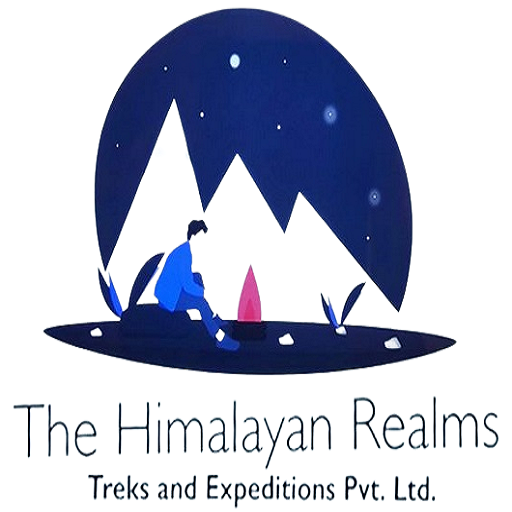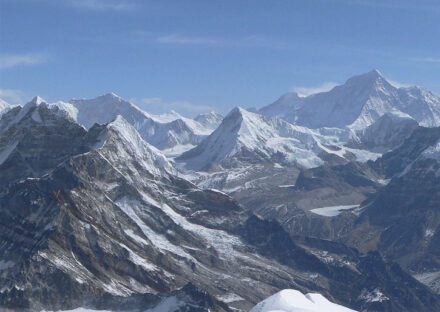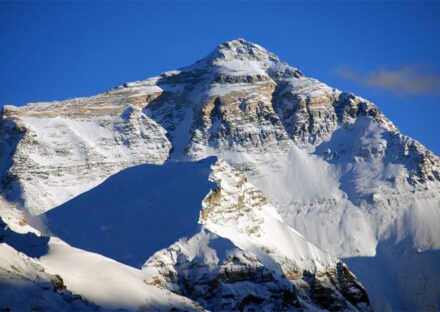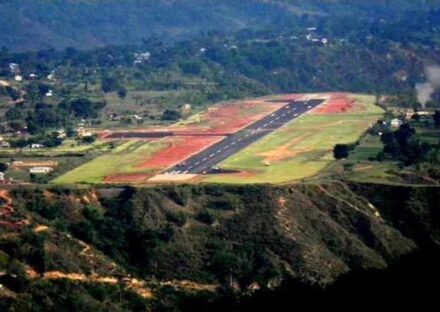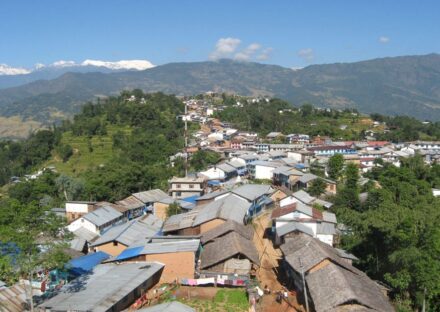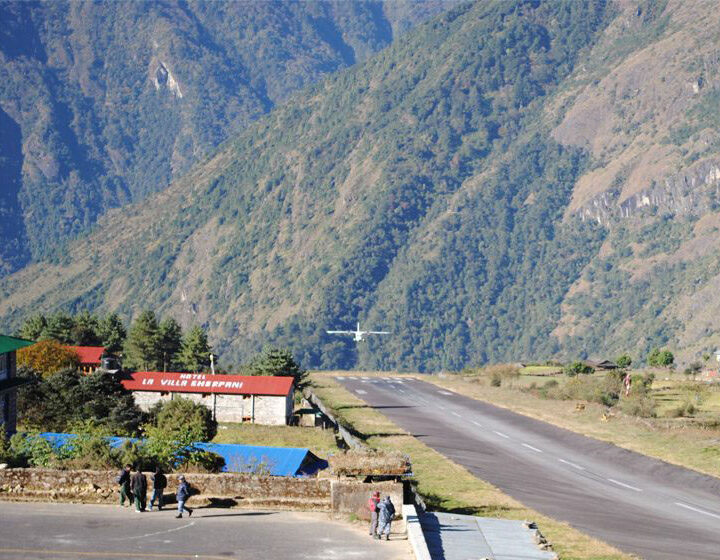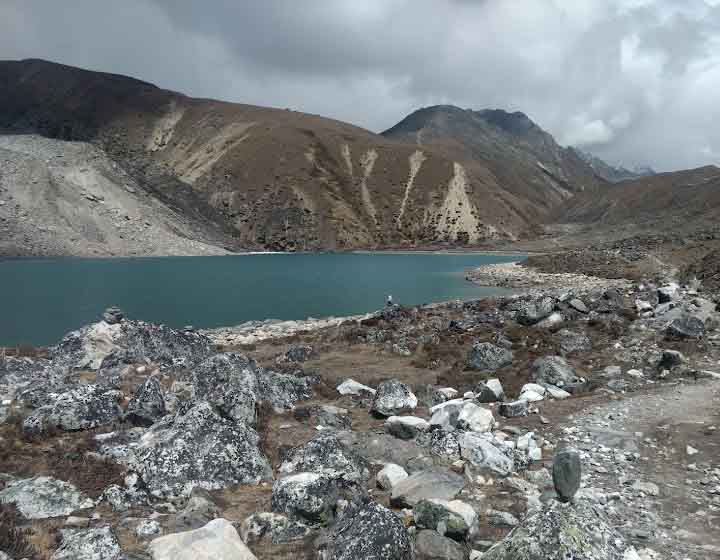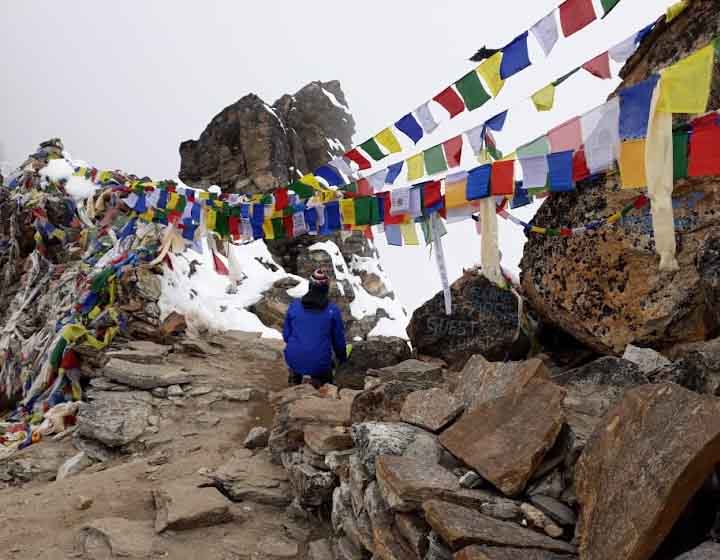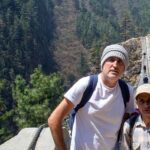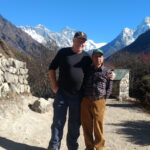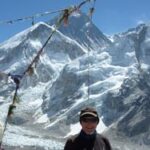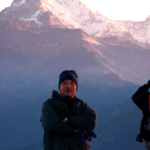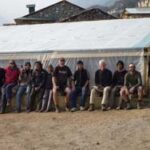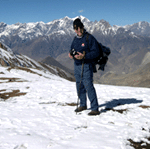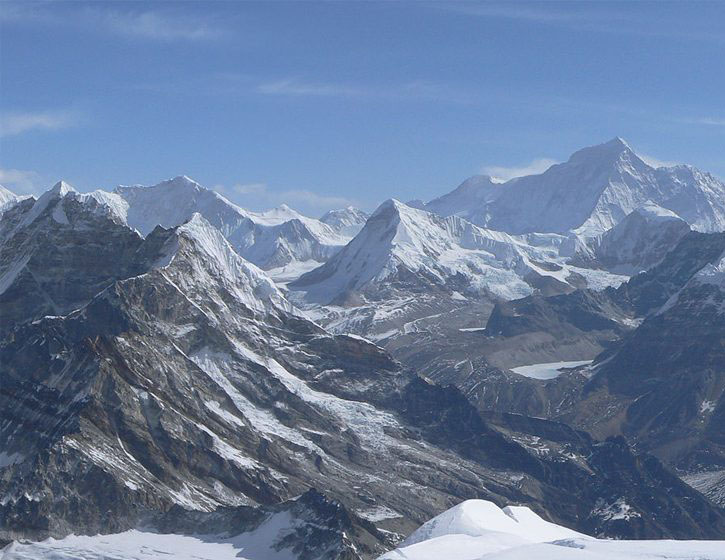
Trip overview

Overview: Makalu Base Camp 23-days trek
The Makalu Base Camp Trek is one of the most remote and spectacular trekking adventures in Nepal. Towering at 4,870 meters (15,978 feet), the Makalu base camp Hiking is lies beneath the world’s fifth-highest mountain, Mount Makalu (8,481 meters / 27,825 feet). The Makalu Base Camp Hiking offers an unmatched journey through pristine forests, high-altitude terrains, and traditional villages where ancient cultures thrive.
Location
Makalu Base Camp hiking is located in the Sankhuwasabha District of eastern Nepal, inside the Makalu Barun National Park, which is an extension of the Sagarmatha (Everest) ecosystem. The region borders the mighty Everest to the northwest and the Arun River valley to the south.
Settlement of the people
The Makalu Base Camp trek is in lower regions, which are dotted with small settlements inhabited mainly by the Rai, Sherpa, and Limbu ethnic groups. Villages like Num, Seduwa, and Tashigaon are traditional and rustic, offering trekkers glimpses of life untouched by modernity.
Tumlingtar
Tumlingtar is a small yet important town located in eastern Nepal, in the Sankhuwasabha District of Koshi Province. Nestled on a wide plateau between the Arun and Sabha rivers, Tumlingtar sits at an altitude of approximately 460 meters (1,509 feet) above sea level.
It serves as the gateway to the Makalu Base Camp Trek and many other adventures in the Makalu Barun region. Tumlingtar is home to a domestic airport — Tumlingtar Airport — connecting it with Kathmandu by short flights, making it a crucial starting point for trekkers and expedition groups.
The town is known for its diverse ethnic communities, including Rai, Limbu, Sherpa, Gurung, and Newar, who live together in harmony. The atmosphere in Tumlingtar is warm, relaxed, and welcoming, providing trekkers with a comfortable transition from bustling Kathmandu to the serenity
Himalayan Lifestyle
The Makalu Base Camp Trek typically begins with a scenic flight from Kathmandu to Tumlingtar. From Tumlingtar, trekkers first head toward Khandbari, a vibrant hill town that serves as the administrative center of Sankhuwasabha District.
After landing at Tumlingtar Airport, a short drive or walk (about 3 to 4 hours) takes trekkers to Khandbari, where they often spend the first night to organize gear, enjoy local hospitality, and begin acclimatization. From Khandbari, the trail gradually ascends through beautiful forests, traditional villages, and terraced farmlands, leading towards the higher elevations of Seduwa, Tashigaon, Khongma Danda, and ultimately to Makalu Base Camp.
About Khandbari
Just about 13 kilometers uphill from Tumlingtar lies Khandbari, which is a district headquarters of Sankhuwasabha. Sitting at around 1,040 meters (3,412 feet) altitude, Khandbari is a larger and more developed town compared to Tumlingtar, featuring government offices, schools, hospitals, banks, markets, and decent accommodations. Khandbari is not just an administrative center — it’s a cultural hub where visitors can observe a lively blend of traditional and modern life. Local bazaars bustle with activity, offering insight into the region’s agricultural richness and craftsmanship.
Agriculture and Daily Life
Most of the people in Khandbari depend on subsistence farming. They cultivate crops like rice, maize, millet, wheat, and seasonal vegetables. Terraced fields surrounding the town showcase traditional farming methods passed down through generations. Animal husbandry, especially raising goats, cattle, and poultry, is also common.
Community and Social Life
Life in Khandbari is community-oriented. People celebrate many cultural festivals, such as Dashain, Tihar, Sakela (Rai festival), and Lhosar (Sherpa New Year), with enthusiasm. Traditional music, dance, and communal gatherings are integral to social life. Neighborhoods are lively with local markets (bazaars), tea shops, and temples where people meet daily. There is a strong sense of hospitality, and visitors often experience genuine warmth and friendliness from the locals.
Modern Influence
In recent years, Khandbari has seen growth in infrastructure — better roads, mobile connectivity, schools, health posts, and small businesses. Many young people pursue education and professional careers, sometimes moving to Kathmandu or abroad, but they retain strong ties to their hometown. The younger generation blends modern clothing, technology, and ideas with traditional values, creating a dynamic and evolving lifestyle.
Cultural Diversity
Khandbari is home to various ethnic groups, including Rai, Limbu, Gurung, Sherpa, Brahmin, and Chhetri. Each group has preserved its own language, customs, and traditions, enriching the cultural fabric of the town. Multilingualism is common, and festivals from different cultures are celebrated harmoniously.
Trekkers often pass through Khandbari en route to higher trails like Makalu Base Camp or even towards remote passes leading into the Arun and Barun valleys. The town is surrounded by beautiful hills, terraced fields, and thick forests, making it a pleasant place to acclimatize or explore before beginning longer treks.
Culture, Religion, and Lifestyle
The culture in this region is a blend of Hindu and Buddhist traditions. Festivals, local dances, and simple living characterize the cultural scene.
Religion
The Rai people predominantly follow a blend of animistic traditions and Hindu practices, while the Sherpa communities practice Tibetan Buddhism. Colorful monasteries, prayer flags, and Mani walls are part of the landscape.
Lifestyle
The lifestyle is agrarian; people engage in farming, yak herding, and trading. Life here is deeply connected to nature and spiritual practices, with deep respect for the mountains.
Vegetation
Makalu Barun National Park is a treasure trove of biodiversity. The vegetation changes dramatically with altitude: Lower region: lush rhododendron forests, bamboo groves, and dense tropical forests. Mid region: pine, fir, and oak forests. Higher region: Alpine meadows with wildflowers and sparse shrubs near the base camp.
Maximum Height
The highest point on the trek is Makalu Base Camp at 4,870 meters (15,978 feet). Some side hikes around the base camp can reach slightly higher altitudes if trekkers choose to explore further viewpoints.
Atmosphere
The atmosphere of the Makalu region is serene and wild. It’s less crowded compared to popular treks like Everest Base Camp or Annapurna Circuit, offering peace, pure natural beauty, and a profound sense of adventure. The high-altitude landscapes are dramatic, with towering icefalls, hanging glaciers, and rocky outcrops.
services
At The Himalayan Realms Treks and Expedition Nepal Pvt. Ltd., we specialize in remote and authentic trekking adventures. Founded with passion and expertise, we are dedicated to offering exceptional service, customized itineraries, and the safest trekking experiences in Nepal. Our experienced guides are local experts who are intimately familiar with the Makalu region’s terrain, culture, and climate.
The Makalu Base Camp Trek package includes:
Airport pick-up and drop-off services in Kathmandu. Domestic flights (Kathmandu–Tumlingtar–Kathmandu). All ground transportation. All meals (breakfast, lunch, and dinner) during trekking. Twin-sharing lodge accommodation during the trek. Experienced licensed English-speaking trekking guide and porter. Necessary trekking permits (Makalu Barun National Park Entry Permit, TIMS card). First aid kit and safety equipment. Company service charge and government taxes. Not Included: Personal insurance, drinks, tips, and personal gear.
Why Trek with Us?
Local Expertise: Deep local knowledge for a safe and enriching experience.
Custom Itineraries: Flexible trekking plans tailored to your preferences. Eco-Conscious: We practice responsible trekking that respects nature and communities. Safety First: Our guides are trained in first aid and altitude management.
Authentic Experiences: We focus on real, raw trekking adventures, far from commercialized paths.
Small Groups: More personalized service and less environmental impact.
Other popular trekking routes include
Annapurna Circuit Trek
Gokyo, Chola-pass Trek 19 days
Makalu Arun Valley Trek 19 days
Conclusion of the Makalu Base Camp Trek
Makalu Base Camp Trek
The Makalu Base Camp Trek offers a truly remote and awe-inspiring adventure into the untouched heart of the Himalayas. Perfect for experienced trekkers seeking solitude, raw natural beauty, and a true wilderness experience, this journey rewards with breathtaking views of Mount Makalu (8,464 m)—the world’s fifth-highest mountain.
The Makalu Base Camp hike winds through Makalu Barun National Park, offering diverse landscapes from lush forests to high-altitude alpine terrains. Along the way, trekkers experience a region rich in cultural heritage and biological diversity. As a result, offering both spiritual tranquility and a formidable physical challenge, the Makalu Base Camp trek becomes a once-in-a-lifetime experience for those bold enough to venture off the beaten path.
Short Itinerary
Included
- All airport and hotel transfers
- 2 Night Accommodation in Kathmandu with B/B plan
- Makalu, Barun National park permit
- Kathmandu to Tumlingtar round trips flight fear for guest and guide
- Bus ticket from Kathmandu to Tumlingtar round trips for staffs
- Accommodation, food, & Tea/coffee during treks
- Guide:- including salary, insurance, equipment, bus transportation, flight fare, food and lodging
- Porter:- including salary, insurance, equipment, bus transportation, food and lodging
- All government and local taxes
Not Included
- Food in Kathmandu ( Lunch & Dinner)
- Nepal Visa fee
- International airfare from your country to Kathmandu and from Kathmandu
- Extra night accommodation in Kathmandu
- ravel and rescue insurance if guest get mountain sickness and need to rescue helicopter.
- Personal expenses example (phone calls, laundry service , bar bills, battery recharge, extra porters, bottle or boiled water, shower etc)
- Tips for guide and porters
Join Us Upcoming Trips
Book this trip with us. Here are the upcoming dates. Feel free to share this trip with your friends and family. For custom trips or general inquiries contact us.
| Departure Date | Trip Duration | Price | Status | |
|---|---|---|---|---|
| 15 September, 2025 | 23 days | $3290 | Fixed departure | |
| 05 October, 2025 | 23 days | $3290 | Fixed departure | |
| 25 October, 2025 | 23 days | $3290 | Fixed departure | |
| 05 November, 2025 | 23 days | $3290 | Fixed departure | |
| 25 November, 2025 | 23 days | $3290 | Fixed departure | |
| 15 December, 2025 | 23 days | $3290 | Fixed departure |
Useful Info
Makalu Base Camp—23-day (MBC) trek, covering everything you’ll need to know—from logistics and itinerary to permits, difficulty, packing, and key highlights.
Overview & Highlights
Region: Makalu Barun National Park, eastern Nepal. Duration: ~23 days (including Kathmandu arrival/departure days). Max Altitude: ~4,870 m at Makalu Base Camp. Difficulty: Strenuous—long days, high passes, remote trails
Highlights: Deep, lush valleys of the Arun and Barun rivers. Panoramic views of Makalu (8,485 m), Everest, Lhotse, and Kangchenjunga. Rich biodiversity: rhododendron forests, rare wildlife (red panda, musk deer). Traditional Sherpa, Rai, and Limbu villages. Crossing Shipton La (4,216 m) into the Barun Valley
Note: Daily hiking hours are approximate. Weather, group pace, and trail conditions can extend these.
Permits & Regulations
1. TIMS Card (Trekkers’ Information Management System): required
2. Makalu Barun National Park Permit: USD 30 per person (subject to change)
3. Local Conservation Fee: NPR 3,000 per person. Permit fees are payable in Kathmandu or Tumlingtar.
Best Seasons
Monsoon (Spring): Mid-March to May: Warm days, rhododendron flowering
Post-Monsoon (Autumn): Late September to November Clear skies and stable weather. Avoid monsoon (June–August) and deep winter (Dec–Feb) due to heavy rain/snow and road/air disruptions.
Physical & Technical Difficulty
Altitude Gain: High—adequate prior high-altitude experience recommended. Trek Grade: Strenuous. Trail Conditions: Remote, sometimes narrow and rocky; river crossings on suspension bridges. Acclimatization: Critical—don’t skip rest days at Shipton La and MBC
Packing Essentials
Clothing: Warm insulated down jacket & pants. Waterproof shell jacket & trousers. Thermal base layers & fleece mid-layers. Trekking pants & shorts. Hat, gloves (liner + insulated), buff
Footwear: Well-broken-in waterproof trekking boots. Comfortable camp shoes/sandals
Sleeping & Shelter: 4-season down sleeping bag (rated to −15 °C or lower). Lightweight sleeping pad
Gear: 40–50 L daypack + 60–70 L duffel or backpack. Trekking poles. Headlamp (plus spare batteries). Sunglasses (UV protection) & glacier glasses for snow glare. Sunscreen (SPF 50+) and lip balm
Health & Safety: Basic first-aid kit & personal medications. Water purification (Steripen or drops). Altitude sickness medication (e.g., Acetazolamide)
Miscellaneous: Portable power bank & charging cables. Camera + extra memory cards/snacks/energy bars
Logistics & Tips
Guide & Porter: Highly recommended for navigation, load-carrying, and local insight. Communication: Sporadic mobile signal; consider renting a local SIM (Ncell) or satellite phone for emergencies. Accommodation: tea Tea houses with basic twin rooms and shared bathrooms; simple meals (dal-bhat, noodles, soups). Hydration & Nutrition: Drink at least 3–4 L of boiled/purified water per day; carry electrolyte tablets
Environmental Responsibility: Pack out all non-biodegradable waste/minimize plastic use; bring a reusable water bottle. Respect local customs and flora/fauna regulations in the National Park
FAQs
-
What is the Makalu Base Camp Trek?
The Makalu Base Camp Trek is a remote and adventurous journey to the base of Mount Makalu (8,481m), the fifth highest mountain in the world. This 23-day trek offers unspoiled wilderness, rich biodiversity, and stunning Himalayan landscapes.
-
How difficult is the trek?
This is a strenuous trek suited for experienced trekkers. It involves long walking days, steep ascents and descents, and high-altitude trekking (up to 5,000m+). Good physical fitness and previous high-altitude trekking experience are recommended.
-
When is the best time to do this trek?
The best seasons are: Spring (March to May) – Rhododendrons bloom and views are clear. Autumn (September to November) – Stable weather and excellent visibility.
-
Do I need a special permit for this trek?
Yes, you'll need: Makalu Barun National Park Permit TIMS Card
-
How do we get to the starting point of the trek?
You’ll typically take a flight from Kathmandu to Tumlingtar, then drive to Num, the trailhead. Return is the same route.
-
Is travel insurance required?
Yes, comprehensive travel insurance with emergency evacuation coverage is mandatory for this trek.
